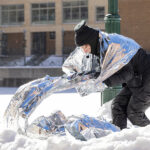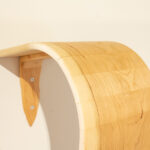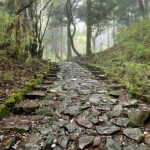Sacred Texts/Contemporary Forms exhibit explores spiritual traditions in the digital age
Jan. 16 – Feb. 24, 2007
Tues.- Sat. 10 a.m. – 5 p.m.
Panel Discussions, Feb. 7, 14, 21;
7 – 9 p.m. Frederick Layton Gallery
In a globe-spanning exhibition, MIAD professor and curator Leslie Fedorchuk has brought together 30 artists who examine and reveal sacred texts in both revolutionary and traditional ways amid our rapidly changing digital culture.
The online catalog for the exhibition is now available at stcf.miad.edu.
The artists’ interpretations of timeless and varied spiritual messages through 70 plus works raise questions that art and faith often pose – a search for meaning and connections to both the past and the future.
- To hear Leslie Fedorchuk’s interview on WUWM’s (89.7 FM) Lake Effect program, click here.
- To see some of the exhibited books as shown by Fedorchuk to Milwaukee Journal Sentinel Visual Arts Reporter Mary Louise Schumacher, click here.
- To learn more about the exhibition, read Schumacher’s print story, “Turning Sacred Pages”.
- Read Leslie Fedorchuk’s blog on the Sacred Texts / Contemporary Forms project at stcfblog.blogspot.com.
- For a personal tour of the exhibition, please e-mail Fedorchuk at lfedorch@miad.edu.
The works in Sacred Texts/Contemporary Forms represent such faith traditions as Buddhism, Christianity, Baha’ism, Hmong shamanism, Islam, Judaism, Maya and Wicca. They are as simple as penned books in an indigenous Spanish dialect by a shaman from Chiapas, Mexico, and feather “books” by an Ojibwa from St. Ignace, Michigan, that are more sculptural objects than traditional books.
But they are also as detailed and crafted as seven digital facsimiles from the Saint John’s Bible, the first bible to be written and illustrated in the Benedictine monastic tradition in more than 500 years. Commissioned by Saint John’s Abbey and Saint John’s University, the bible has been created using ancient techniques (eggs, quills, calf-skins, and hand-ground inks with gold, silver and platinum) combined with modern touches, such as strands of DNA gracefully entwined up the branches of Jesus’ ancestral tree, to produce a contemporary masterpiece.
And they include the idea of the book as an interactive object in a variety of ways, including four ancient texts that viewers can manipulate on a kiosk.
According to Fedorchuk, who traveled the country for a year doing research, “The exhibition engages the viewer through varied access points, both familiar and unfamiliar, in exploring sacred texts as interpreted by contemporary artists working with digital and traditional media. The processes of thought and physical action that are the artists’ methods of creation compel viewers to ‘bear witness’ to the journey of the text. This journey is one of history, of the solitary works of the artists, and finally, of a personal response.”
Other exhibition works, which are on loan from artists, library collections and fine book dealers, include:
Root Words: An Alphabetic Exploration, by Lynne Avadenka in collaboration with Mohamed Zakariya, of the Hebrew and Arabic languages through seven calligraphically rendered words whose meanings are the same and whose pronunciations are close. The words are framed by images made by Avadenka inspired by the combined beauty of the Hebrew and Arabic letterforms. The book opens to 77 inches; its 16 leaves are bound concertina style with 28 folios. Avadenka will participate in the first of three panel discussions accompanying the exhibit in February
Midnight Song: by Caren Heft with text by Alan Govenar: A six-page narrative on Hmong shaman Boua Xou Mua; the spiritual leader of his people who was a mercenary for the French and the CIA in Laos. The book is printed in an eclectic page size and includes one of the shaman’s poems. Laid in a fitted compartment is a CD “The Music of the Hmong People of Laos: Documentary Arts” by the shaman.
Incantations by Mayan Women: Amber Past and the Taller Leñateros paper and bookmaking collective: the first book Mayan people have created and bound in paper of their own making in nearly 500 years. A strikingly beautiful volume made from 295 pages with silk-screen illustrations. The cover is a three-dimensional rendering of the face of Kaxall, Mayan goddess of the wilderness, in recycled cardboard mixed with corn silk and coffee. The book contains spells and hymns recorded by the women that are transcribed and translated from Tzotzil into Spanish and English.
Fragments of Light II: conceived and designed by Kelly Driscoll; translated by Zahra Partove. One of only 35 copies, each comprising seven plates of Depp Glass, each plate with a laser etch of the English translation of the verse of 13th century Sufi philosopher and poet Jalaluddin Mohammad Rumi. The laser etches of this extraordinarily beautiful book sculpture, which includes a laser etch of the original Persian verse, are visible to the viewer through to the bottom from the top.
Sacred Geography: Poems of the Himalaya and Tibet, by Mary Heebner in collaboration with her daughter, Sienna Craig, whose 12 sonnets are printed on handmade pulp-painted paper by the artist. The book’s format depicts the loose-leafed books of Buddhist sutra and classical texts of Nepal’s Mustang district and Tibet. It was inspired by Heebner’s visits to her daughter in Nepal and Tibet, by the sacred colors of striped mani (Tibetan prayers) etched into a wall of boulders, and by ammonite fossils known as saligram in Sanskrit and Nepali.
Sacred Texts/Contemporary Forms continues the Culture in Transition series inaugurated by MIAD’s Director of Galleries Mark Lawson in 2006 to explore the rapidly changing nature of our global culture. It and its three accompanying panel discussions are supported in part by grants from the Milwaukee Arts Board and the Wisconsin Humanities Council. The panels will be held at MIAD, Wednesdays, February 7, 14, 21; 7 – 9 p.m. They are:
- February 7: Contemporary Book Arts – An historical perspective of the contemporary books in the exhibit and how and why they were made.
Panelists include: Betty Bright, Author and former curator for the Minnesota Center for Book Arts; Max Yela, Special Collections Librarian, UW-Milwaukee; contemporary book/exhibiting artists Lynne Avadenka and Elsi Vassdal Ellis. - February 14: Sacred Texts – Representatives of the myriad faith traditions in the exhibition will discuss the roles of historical texts and their current use.
Panelists include: Catherine Burdick, doctoral candidate in Meso-American Studies at the University of Illinois; Reverend Selena Fox, Senior Minister, Circle Sanctuary, Barneveld, Wis.; Moshe Katz, Milwaukee businessman/community activist; Reverend Tonen O’Connor, Resident Priest, Milwaukee Zen Center; Susan K. Wood, Professor of Theology, Marquette University - February 21: The Digital Future of Books – A discussion of how digital technology is changing the dissemination of information using sacred texts to move toward the broader issues involved.
Panelists include: Matt Blessing, Head of Special Collections and Archives, Marquette University; James Canary, Head of Special Collections Archive, Lilly Library, Indiana University; Cynthia Lynch, Librarian, Milwaukee Institute of Art & Design; Max Yela, Special Collections Librarian, UW-Milwaukee.
{mospagebreak title=Participating Artists}
Participating Artists
(with current location or origin of work)
Kim Anno
Berkeley, California
Charles Robert Ashbee, Essex House Press
Great Britain
Lynne Avadenka, Land Marks Press
Huntington Woods, Michigan
Mare Blocker, M Kimberly Press
Walla Walla, Washington
Julie Chen, Flying Fish Press
Berkeley, California
Nancy Culmone
Serafina, New Mexico
Ediciones Dos Amigos
Buenos Aires, Argentina
Elsi Vassdel Ellis, Eve Press
Bellingham, Washington
Cari Ferraro
San Jose, California
Diane Fine & Beth Kaplan Fine, Moonkosh Press
Plattsburgh, New York
Vincent Fitzgerald & Co., et al
New York, New York
Elliott Grondin
St. Ignace, Michigan
Mary Heebner, Simplemente Maria Press
Santa Barbara, California
Caren Heft, Arcadian Press
Stevens Point, Wisconsin
Donald Jackson, et al.
Monmouth, Wales
Susan Kapuscinski-Gaylord
Newburyport, Massachusetts
Steven Krueger, Turkey Hill Press
Milwaukee, Wisconsin
Michael Kuch, Double Elephant Press
Hadley, Massachusetts
Mary Laird, Quelquefois Press
Berkeley, California
Frank Lalou
Namur, Belgium
Nancy Leavitt
Stillwater, Maine
Cynthia Marsh
Clarksville, Tennessee
Catherine Michaelis, May Day Press
Olympia, Washington
Jeffrey W. Morin, Sailor Boy Press
Stevens Point, Wisconsin
David Moss
Jerusalem, Israel
Ámbar Past, Taller Leñateros
San Cristóbal de Las Casas, Mexico
PRAXIS, Brainard Carey and Delia Bajo
New Haven, Connecticut
Peggy Prentice (and John Risseeuw)
Eugene, Oregon
Robin Price
Middletown, Connecticut
Sue Ann Robinson
Long Beach, California
Douglas Shafer
Portland, Oregon
Robbin Ami Silverberg, Dobbin Books
New York, New York
Jessica Spring, Springtide Press
Tacoma, Washington
Margaret Sunday, Caddis Case Press
Greely, Colorado
Alfonso Garcia Tellez
San Pablito, Mexico
Jim Trissel, The Press at Colorado College
Colorado Springs, Colorado
Fahimeh Vahdat (MIAD) and Brian Carlson
Milwaukee, Wisconsin
Pamela Zwehl-Burke
Santa Ynez, California
HISTORICAL TEXTS
Facsimiles:
Kennicott Bible, Facsimile Editions
London, England
Digital Books on Monitors:
Sultan Baybars’ Qur’an
Cairo, Egypt
Diamond Sutra
Dunhuang, China
Lindisfarne Gospels
Lindisfarne, England
The Golden Haggadah
Barcelona, Spain





